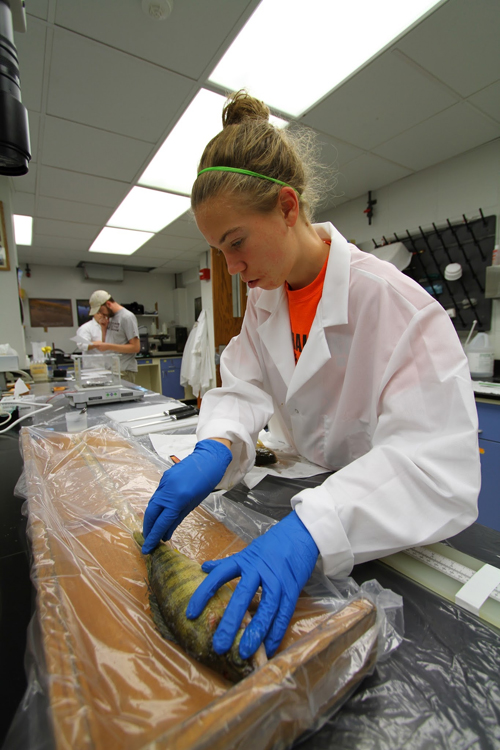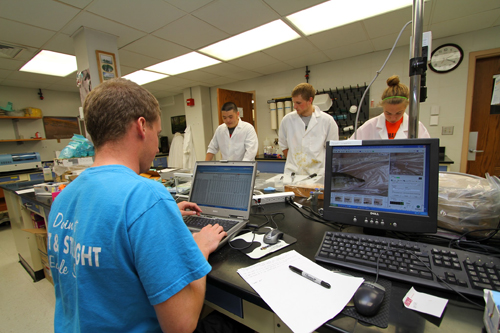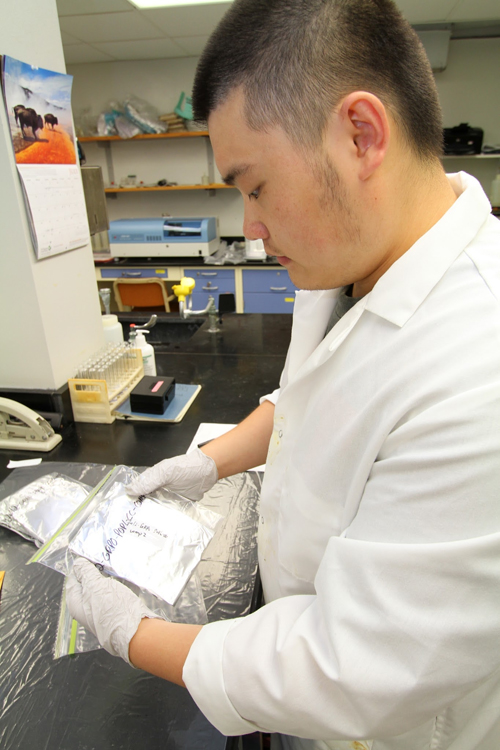Posted 3:44 p.m. Tuesday, July 17, 2012

 [/caption]
In mid May, UW-L student and faculty researchers take their poles and nets to the waters of the Great Lakes region. But the large fish they haul in aren’t for eating. These fish, along with aquatic insects, sediment and other samples from the waters will become the subject of months of summer lab research.
Over the last three years, UW-L researchers have measured the level of mercury and other contaminants in fish and other aquatic life in national parks of the Great Lakes region. While they’ve found low amounts of lead, PCBs and other contaminants, levels of methylmercury continue to be a major concern. The research is one of many ongoing projects related to natural resource issues in the Upper Midwest coordinated by UW-L's River Studies Center.
Mercury pollution has increased considerably in the air and waterways globally since the industrial revolution as a result of fossil fuel combustion, burning waste, mining and other industrial processes. This pollution has spurred research initiatives and subsequent fish consumption advisories across the nation. Some members of the population are particularly vulnerable, such as pregnant women who eat large quantities of mercury-contaminated fish. They risk impacting the development of their fetuses because of mercury’s effects on fetal brain tissue and intelligence.
UW-L Professor of Biology Mark Sandheinrich says mercury is not only a concern for humans.
“We have concerns for humans, but our expertise is fish and wildlife,” says Sandheinrich, who heads UW-L’s River Studies Center. “We are looking at how this mercury in the water is transferred along the aquatic food web and we’re looking at the effects of it.”
What students, faculty are learning from fish
On a hot July day, five UW-L student researchers are in a cool Cowley Hall basement lab. Immune to the fish odor around them, they pull frozen walleye and bass from a freezer and lay them on a long steel table.
“It’s been worse,” jokes UW-L student Laura Jacobson regarding the lab’s smell.
[caption id="attachment_13406" align="alignright" width="500" caption="UW-L student Patrick Schulze enters fish measurements into the computer as UW-L students from left, Yang Liu, Greg Perrine and Laura Jacobson take measurements."]
[/caption]
In mid May, UW-L student and faculty researchers take their poles and nets to the waters of the Great Lakes region. But the large fish they haul in aren’t for eating. These fish, along with aquatic insects, sediment and other samples from the waters will become the subject of months of summer lab research.
Over the last three years, UW-L researchers have measured the level of mercury and other contaminants in fish and other aquatic life in national parks of the Great Lakes region. While they’ve found low amounts of lead, PCBs and other contaminants, levels of methylmercury continue to be a major concern. The research is one of many ongoing projects related to natural resource issues in the Upper Midwest coordinated by UW-L's River Studies Center.
Mercury pollution has increased considerably in the air and waterways globally since the industrial revolution as a result of fossil fuel combustion, burning waste, mining and other industrial processes. This pollution has spurred research initiatives and subsequent fish consumption advisories across the nation. Some members of the population are particularly vulnerable, such as pregnant women who eat large quantities of mercury-contaminated fish. They risk impacting the development of their fetuses because of mercury’s effects on fetal brain tissue and intelligence.
UW-L Professor of Biology Mark Sandheinrich says mercury is not only a concern for humans.
“We have concerns for humans, but our expertise is fish and wildlife,” says Sandheinrich, who heads UW-L’s River Studies Center. “We are looking at how this mercury in the water is transferred along the aquatic food web and we’re looking at the effects of it.”
What students, faculty are learning from fish
On a hot July day, five UW-L student researchers are in a cool Cowley Hall basement lab. Immune to the fish odor around them, they pull frozen walleye and bass from a freezer and lay them on a long steel table.
“It’s been worse,” jokes UW-L student Laura Jacobson regarding the lab’s smell.
[caption id="attachment_13406" align="alignright" width="500" caption="UW-L student Patrick Schulze enters fish measurements into the computer as UW-L students from left, Yang Liu, Greg Perrine and Laura Jacobson take measurements."] [/caption]
They are “measuring the fluctuating asymmetry of the fish,” she explains. Species in nature tend to have symmetry and, when they don’t, that could signal a problem. Students measure the fins and other parts of the fish to see if they are asymmetric and if mercury levels in the fish are related to any asymmetry they might find. They also weigh the fish and use a freeze-drying process to determine the amount of mercury contamination in each specimen.
“In this lab, you learn just how important accuracy is,” says Jacobson.
Precision comes in handy for a lot of sciences, says UW-L student Greg Perrine. The senior plans to go to graduate school for forensic science.
“This is big preparation for what I’ll do later,” he explains. “To take something small and measure it accurately is really important — especially if someone’s guilt or innocence is on the line.”
Unlike forensic science, UW-L’s research won’t determine whether someone goes to jail. But it will help researchers better understand how mercury works its way up the food chain and what that might mean for fish and other wildlife. They’ve found problems typically turn up in reproduction, says Sandheinrich. UW-L students and River Studies Center faculty published some of the first research about the effects of mercury on fish reproduction in 2002 and 2003. That and subsequent studies at UW-L have found fish with elevated mercury levels in their system have a decreased ability to reproduce. Studies have also shown loons, who eat large quantities of fish, encounter the same problem.
“We can’t say right now whether mercury has a devastating effect on fish population, but we can say we do see effects on things like hormone production in the fish, the condition of the fish and changes in cell structure,” Sandheinrich.
Why should we be concerned about mercury contamination if it is not necessarily killing fish? Sandheinrich compares it to America’s obesity epidemic.
“Even though the population of obese people is a large percentage of the population, individuals in that population may not be as healthy as they could be and there is a cost associated with that,” he says. “With fish there are economic, cultural and societal costs if humans can’t use those populations to the fullest extent.”
While mercury levels in the Great Lakes region have been on the decline over the past four decades, the levels of mercury still exceed human and ecological risk threshholds in many areas and may be on the rise in some species and locations. The effects of mercury pollution on fish and wildlife occur at lower mercury concentrations than previously reported, according to the 2011 report “Great Lakes Mercury Connections” produced by several organizations, including the River Studies Center.
The many facets of UW-L’s River Studies Center
[caption id="attachment_13409" align="alignright" width="500" caption="UW-L student Yang Liu says lab taught him skills such as troubleshooting and teamwork."]
[/caption]
They are “measuring the fluctuating asymmetry of the fish,” she explains. Species in nature tend to have symmetry and, when they don’t, that could signal a problem. Students measure the fins and other parts of the fish to see if they are asymmetric and if mercury levels in the fish are related to any asymmetry they might find. They also weigh the fish and use a freeze-drying process to determine the amount of mercury contamination in each specimen.
“In this lab, you learn just how important accuracy is,” says Jacobson.
Precision comes in handy for a lot of sciences, says UW-L student Greg Perrine. The senior plans to go to graduate school for forensic science.
“This is big preparation for what I’ll do later,” he explains. “To take something small and measure it accurately is really important — especially if someone’s guilt or innocence is on the line.”
Unlike forensic science, UW-L’s research won’t determine whether someone goes to jail. But it will help researchers better understand how mercury works its way up the food chain and what that might mean for fish and other wildlife. They’ve found problems typically turn up in reproduction, says Sandheinrich. UW-L students and River Studies Center faculty published some of the first research about the effects of mercury on fish reproduction in 2002 and 2003. That and subsequent studies at UW-L have found fish with elevated mercury levels in their system have a decreased ability to reproduce. Studies have also shown loons, who eat large quantities of fish, encounter the same problem.
“We can’t say right now whether mercury has a devastating effect on fish population, but we can say we do see effects on things like hormone production in the fish, the condition of the fish and changes in cell structure,” Sandheinrich.
Why should we be concerned about mercury contamination if it is not necessarily killing fish? Sandheinrich compares it to America’s obesity epidemic.
“Even though the population of obese people is a large percentage of the population, individuals in that population may not be as healthy as they could be and there is a cost associated with that,” he says. “With fish there are economic, cultural and societal costs if humans can’t use those populations to the fullest extent.”
While mercury levels in the Great Lakes region have been on the decline over the past four decades, the levels of mercury still exceed human and ecological risk threshholds in many areas and may be on the rise in some species and locations. The effects of mercury pollution on fish and wildlife occur at lower mercury concentrations than previously reported, according to the 2011 report “Great Lakes Mercury Connections” produced by several organizations, including the River Studies Center.
The many facets of UW-L’s River Studies Center
[caption id="attachment_13409" align="alignright" width="500" caption="UW-L student Yang Liu says lab taught him skills such as troubleshooting and teamwork."] [/caption]
Mercury contamination is just one of the many areas of study within UW-L’s River Studies Center. The center, in existence for 40 years, brings together UW-L faculty from various disciplines to investigate natural resource issues in the Upper Midwest — particularly in the rivers, lakes and wetlands.
Other areas of study include invasive species such as silver carp and bighead carp in the Mississippi River, nitrogen cycles in the river basin, vegetation in the flood plain and more.
Since 2000, faculty affiliated with River Studies Center have brought more than $12.6 million to the university through grants and contracts. Grants come from various organizations. In May the center received a more than $150,000 from the U.S. Geological Survey for the current fiscal year. That’s in addition to funding from a Cooperative Educational Agreement that UW-L has with the Upper Midwest Environmental Science Center, which has provided more than $10 million for River Studies Center research since 1996.
And the center is making waves. UW-L researchers have been a key voice at international conferences about mercury pollution that have influenced policy on pollution and more advisories about fish consumption. Reports and other published research findings, including more than a dozen in the last year from the center, have provided more information about mercury pollution to the public.
“The work the River Studies Center is doing is extending well beyond La Crosse and having an effect on policy nationally,” says Sandheinrich.
[/caption]
Mercury contamination is just one of the many areas of study within UW-L’s River Studies Center. The center, in existence for 40 years, brings together UW-L faculty from various disciplines to investigate natural resource issues in the Upper Midwest — particularly in the rivers, lakes and wetlands.
Other areas of study include invasive species such as silver carp and bighead carp in the Mississippi River, nitrogen cycles in the river basin, vegetation in the flood plain and more.
Since 2000, faculty affiliated with River Studies Center have brought more than $12.6 million to the university through grants and contracts. Grants come from various organizations. In May the center received a more than $150,000 from the U.S. Geological Survey for the current fiscal year. That’s in addition to funding from a Cooperative Educational Agreement that UW-L has with the Upper Midwest Environmental Science Center, which has provided more than $10 million for River Studies Center research since 1996.
And the center is making waves. UW-L researchers have been a key voice at international conferences about mercury pollution that have influenced policy on pollution and more advisories about fish consumption. Reports and other published research findings, including more than a dozen in the last year from the center, have provided more information about mercury pollution to the public.
“The work the River Studies Center is doing is extending well beyond La Crosse and having an effect on policy nationally,” says Sandheinrich.
